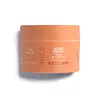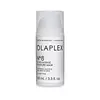What's inside
What's inside
 Key Ingredients
Key Ingredients

 Benefits
Benefits

 Concerns
Concerns

 Ingredients Side-by-side
Ingredients Side-by-side

Water
Skin ConditioningStearyl Alcohol
EmollientBehentrimonium Chloride
PreservativeCetyl Alcohol
EmollientPanthenol
Skin ConditioningIsopropyl Alcohol
SolventQuaternium-80
Phenoxyethanol
PreservativePropylene Glycol
HumectantParfum
MaskingTocopheryl Acetate
AntioxidantMethylparaben
PreservativeGlycerin
HumectantPropylparaben
PreservativeDisodium EDTA
Oleic Acid
EmollientLimonene
PerfumingBenzyl Salicylate
PerfumingHexyl Cinnamal
PerfumingLycium Barbarum Fruit Extract
AstringentCitric Acid
BufferingSodium Benzoate
MaskingLactic Acid
BufferingPotassium Sorbate
PreservativeWater, Stearyl Alcohol, Behentrimonium Chloride, Cetyl Alcohol, Panthenol, Isopropyl Alcohol, Quaternium-80, Phenoxyethanol, Propylene Glycol, Parfum, Tocopheryl Acetate, Methylparaben, Glycerin, Propylparaben, Disodium EDTA, Oleic Acid, Limonene, Benzyl Salicylate, Hexyl Cinnamal, Lycium Barbarum Fruit Extract, Citric Acid, Sodium Benzoate, Lactic Acid, Potassium Sorbate
Water
Skin ConditioningDimethicone
EmollientCetyl Alcohol
EmollientPersea Gratissima Oil
Skin ConditioningGlycerin
HumectantStearyl Alcohol
EmollientEthylhexyl Olivate
Skin ConditioningBehentrimonium Chloride
PreservativeCetrimonium Bromide
AntimicrobialLimnanthes Alba Seed Oil
Skin ConditioningOryza Sativa Bran Oil
EmollientQuaternium-80
Squalane
EmollientRosa Canina Seed Extract
EmollientCeramide AP
Skin ConditioningCeramide NP
Skin ConditioningHydrolyzed Jojoba Esters
Skin ConditioningSodium Hyaluronate
HumectantSodium PCA
HumectantBis-Aminopropyl Diglycol Dimaleate
Skin ConditioningArginine
MaskingJojoba Esters
EmollientPanthenol
Skin ConditioningCarthamus Tinctorius Seed Oil
MaskingCannabis Sativa Seed Oil
EmollientGlycine
BufferingAlanine
MaskingSerine
MaskingValine
MaskingIsoleucine
Skin ConditioningProline
Skin ConditioningThreonine
Guar Hydroxypropyltrimonium Chloride
Skin ConditioningHistidine
HumectantHydroxyethylcellulose
Emulsion StabilisingPhenylalanine
MaskingAspartic Acid
MaskingPCA
HumectantPhosphatidylcholine
EmulsifyingCitric Acid
BufferingSodium Lactate
BufferingEthylhexylglycerin
Skin ConditioningSodium Benzoate
MaskingPhenoxyethanol
PreservativeBis-Cetearyl Amodimethicone
Propylene Glycol
HumectantIsopropyl Alcohol
SolventSodium Nitrate
SoothingTocopherol
AntioxidantParfum
MaskingCitral
PerfumingHexyl Cinnamal
PerfumingLimonene
PerfumingWater, Dimethicone, Cetyl Alcohol, Persea Gratissima Oil, Glycerin, Stearyl Alcohol, Ethylhexyl Olivate, Behentrimonium Chloride, Cetrimonium Bromide, Limnanthes Alba Seed Oil, Oryza Sativa Bran Oil, Quaternium-80, Squalane, Rosa Canina Seed Extract, Ceramide AP, Ceramide NP, Hydrolyzed Jojoba Esters, Sodium Hyaluronate, Sodium PCA, Bis-Aminopropyl Diglycol Dimaleate, Arginine, Jojoba Esters, Panthenol, Carthamus Tinctorius Seed Oil, Cannabis Sativa Seed Oil, Glycine, Alanine, Serine, Valine, Isoleucine, Proline, Threonine, Guar Hydroxypropyltrimonium Chloride, Histidine, Hydroxyethylcellulose, Phenylalanine, Aspartic Acid, PCA, Phosphatidylcholine, Citric Acid, Sodium Lactate, Ethylhexylglycerin, Sodium Benzoate, Phenoxyethanol, Bis-Cetearyl Amodimethicone, Propylene Glycol, Isopropyl Alcohol, Sodium Nitrate, Tocopherol, Parfum, Citral, Hexyl Cinnamal, Limonene
 Reviews
Reviews

Ingredients Explained
These ingredients are found in both products.
Ingredients higher up in an ingredient list are typically present in a larger amount.
This ingredient is a preservative and often used for it's anti-static properties. You'll most likely see this ingredient in hair conditioners.
It does not cause irritation or sensitization in leave-on products at 1-5%.
Cetyl Alcohol is a fatty alcohol. Fatty Alcohols are most often used as an emollient or to thicken a product.
Its main roles are:
Though it has "alcohol" in the name, it is not related to denatured alcohol or ethyl alcohol.
The FDA allows products labeled "alcohol-free" to have fatty alcohols.
Learn more about Cetyl AlcoholCitric Acid is an alpha hydroxy acid (AHA) naturally found in citrus fruits like oranges, lemons, and limes.
Like other AHAs, citric acid can exfoliate skin by breaking down the bonds that hold dead skin cells together. This helps reveal smoother and brighter skin underneath.
However, this exfoliating effect only happens at high concentrations (20%) which can be hard to find in cosmetic products.
Due to this, citric acid is usually included in small amounts as a pH adjuster. This helps keep products slightly more acidic and compatible with skin's natural pH.
In skincare formulas, citric acid can:
While it can provide some skin benefits, research shows lactic acid and glycolic acid are generally more effective and less irritating exfoliants.
Most citric acid used in skincare today is made by fermenting sugars (usually from molasses). This synthetic version is identical to the natural citrus form but easier to stabilize and use in formulations.
Read more about some other popular AHA's here:
Learn more about Citric AcidGlycerin is already naturally found in your skin. It helps moisturize and protect your skin.
A study from 2016 found glycerin to be more effective as a humectant than AHAs and hyaluronic acid.
As a humectant, it helps the skin stay hydrated by pulling moisture to your skin. The low molecular weight of glycerin allows it to pull moisture into the deeper layers of your skin.
Hydrated skin improves your skin barrier; Your skin barrier helps protect against irritants and bacteria.
Glycerin has also been found to have antimicrobial and antiviral properties. Due to these properties, glycerin is often used in wound and burn treatments.
In cosmetics, glycerin is usually derived from plants such as soybean or palm. However, it can also be sourced from animals, such as tallow or animal fat.
This ingredient is organic, colorless, odorless, and non-toxic.
Glycerin is the name for this ingredient in American English. British English uses Glycerol/Glycerine.
Learn more about GlycerinHexyl Cinnamal is a fragrance ingredient with a similar scent to jasmine. It can be naturally found in chamomile essential oil.
This ingredient is a known EU allergen and may sensitize the skin. The EU requires this ingredient to be listed separately on an ingredients list.
Hexyl Cinnamal is not water soluble but is soluble in oils.
Learn more about Hexyl CinnamalIsopropyl Alcohol is more commonly known as rubbing alcohol. It is most commonly used as a solvent, meaning it helps other ingredients dissolve.
This ingredient is an astringent alcohol. Astringent alcohols may also irritate skin as they high amounts may strip away your skin's natural oils.
Other types of astringent alcohols include:
According to the National Rosacea Society based in the US, you should be mindful of products with these alcohols in the top half of ingredients.
Any type of sanitizing product will have high amounts of alcohol to help kill bacteria and viruses.
Learn more about Isopropyl AlcoholLimonene is a fragrance that adds scent and taste to a formulation.
It's found in the peel oil of citrus fruits and other plants such as lavender and eucalyptus. The scent of limonene is generally described as "sweet citrus".
Limonene acts as an antioxidant, meaning it helps neutralize free radicals.
When exposed to air, oxidized limonene may sensitize the skin. Because of this, limonene is often avoided by people with sensitive skin.
The term 'fragrance' is not regulated in many countries. In many cases, it is up to the brand to define this term. For instance, many brands choose to label themselves as "fragrance-free" because they are not using synthetic fragrances. However, their products may still contain ingredients such as essential oils that are considered a fragrance.
Learn more about LimonenePanthenol is a common ingredient that helps hydrate and soothe the skin. It is found naturally in our skin and hair.
There are two forms of panthenol: D and L.
D-panthenol is also known as dexpanthenol. Most cosmetics use dexpanthenol or a mixture of D and L-panthenol.
Panthenol is famous due to its ability to go deeper into the skin's layers. Using this ingredient has numerous pros (and no cons):
Like hyaluronic acid, panthenol is a humectant. Humectants are able to bind and hold large amounts of water to keep skin hydrated.
This ingredient works well for wound healing. It works by increasing tissue in the wound and helps close open wounds.
Once oxidized, panthenol converts to pantothenic acid. Panthothenic acid is found in all living cells.
This ingredient is also referred to as pro-vitamin B5.
Learn more about PanthenolParfum is a catch-all term for an ingredient or more that is used to give a scent to products.
Also called "fragrance", this ingredient can be a blend of hundreds of chemicals or plant oils. This means every product with "fragrance" or "parfum" in the ingredients list is a different mixture.
For instance, Habanolide is a proprietary trade name for a specific aroma chemical. When used as a fragrance ingredient in cosmetics, most aroma chemicals fall under the broad labeling category of “FRAGRANCE” or “PARFUM” according to EU and US regulations.
The term 'parfum' or 'fragrance' is not regulated in many countries. In many cases, it is up to the brand to define this term.
For instance, many brands choose to label themselves as "fragrance-free" because they are not using synthetic fragrances. However, their products may still contain ingredients such as essential oils that are considered a fragrance by INCI standards.
One example is Calendula flower extract. Calendula is an essential oil that still imparts a scent or 'fragrance'.
Depending on the blend, the ingredients in the mixture can cause allergies and sensitivities on the skin. Some ingredients that are known EU allergens include linalool and citronellol.
Parfum can also be used to mask or cover an unpleasant scent.
The bottom line is: not all fragrances/parfum/ingredients are created equally. If you are worried about fragrances, we recommend taking a closer look at an ingredient. And of course, we always recommend speaking with a professional.
Learn more about ParfumPhenoxyethanol is a preservative that has germicide, antimicrobial, and aromatic properties. Studies show that phenoxyethanol can prevent microbial growth. By itself, it has a scent that is similar to that of a rose.
It's often used in formulations along with Caprylyl Glycol to preserve the shelf life of products.
Propylene Glycol is an odorless, colorless liquid. As a humectant, it helps skin retain moisture. It also aids in delivering active ingredients.
Another role of this ingredient is preventing a product from melting or freezing. Propylene glycol also adds antimicrobrial properties to a product, elongating product lifespan.
This ingredient is considered an organic alcohol and commonly added into both cosmetics and foods.
Those with sensitive skin or conditions may develop a rash when using this ingredient.
Learn more about Propylene GlycolWe don't have a description for Quaternium-80 yet.
Sodium Benzoate is a preservative. It's used in both cosmetic and food products to inhibit the growth of mold and bacteria. It is typically produced synthetically.
Both the US FDA and EU Health Committee have approved the use of sodium benzoate. In the US, levels of 0.1% (of the total product) are allowed.
Sodium benzoate works as a preservative by inhibiting the growth of bacteria inside of cells. It prevents the cell from fermenting a type of sugar using an enzyme called phosphofructokinase.
It is the salt of benzoic acid. Foods containing sodium benzoate include soda, salad dressings, condiments, fruit juices, wines, and snack foods.
Studies for using ascorbic acid and sodium benzoate in cosmetics are lacking, especially in skincare routines with multiple steps.
We always recommend speaking with a professional, such as a dermatologist, if you have any concerns.
Learn more about Sodium BenzoateStearyl Alcohol is a type of fatty alcohol from stearic acid. It is a white, waxy compound used to emulsify ingredients.
Fatty Alcohols are most often used as an emollient or to thicken a product. Emollients help soothe and hydrate the skin by trapping moisture.
They are usually derived from natural fats and oils and therefore do not have the same drying or irritating effect as solvent alcohols. FDA allows products labeled "alcohol-free" to have fatty alcohols.
Learn more about Stearyl AlcoholWater. It's the most common cosmetic ingredient of all. You'll usually see it at the top of ingredient lists, meaning that it makes up the largest part of the product.
So why is it so popular? Water most often acts as a solvent - this means that it helps dissolve other ingredients into the formulation.
You'll also recognize water as that liquid we all need to stay alive. If you see this, drink a glass of water. Stay hydrated!
Learn more about Water